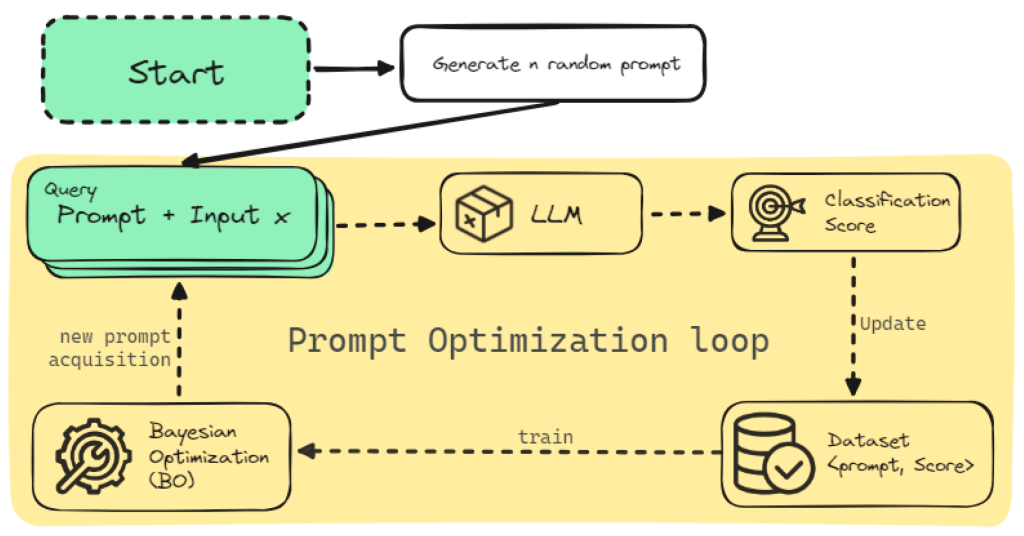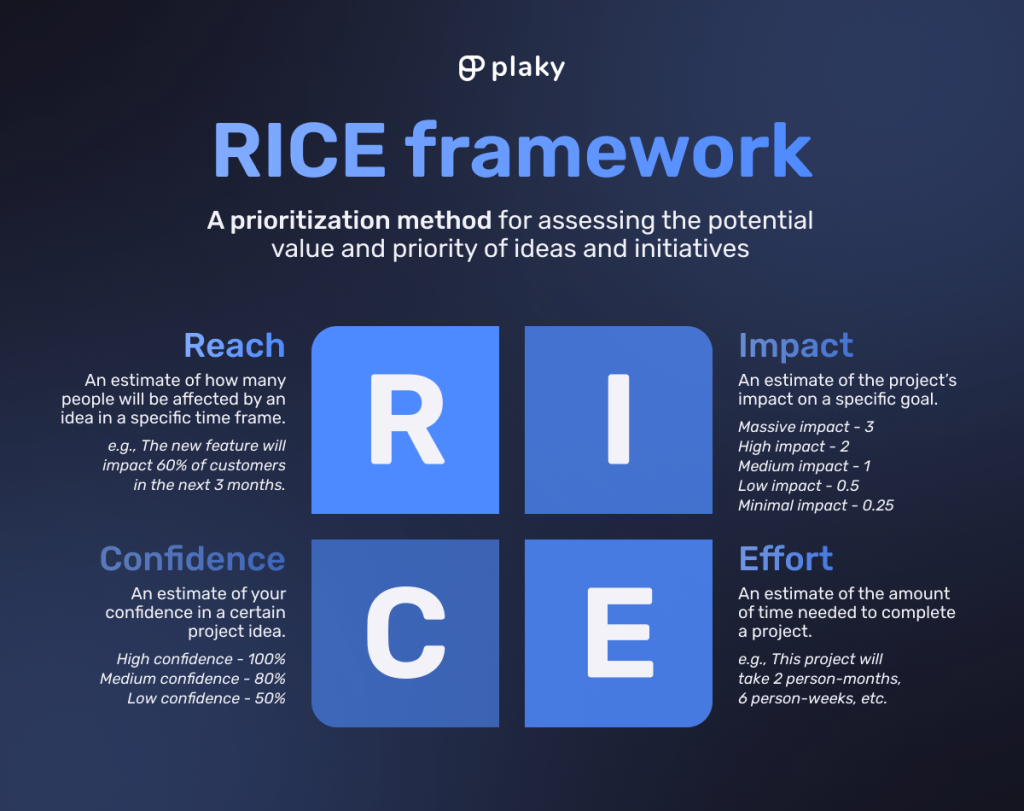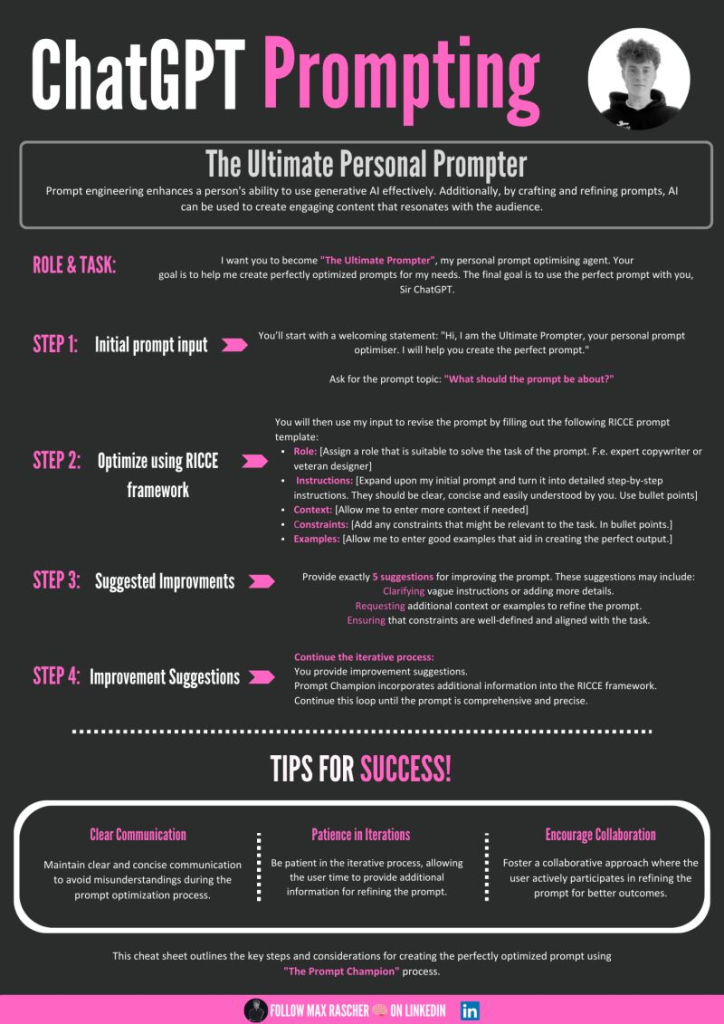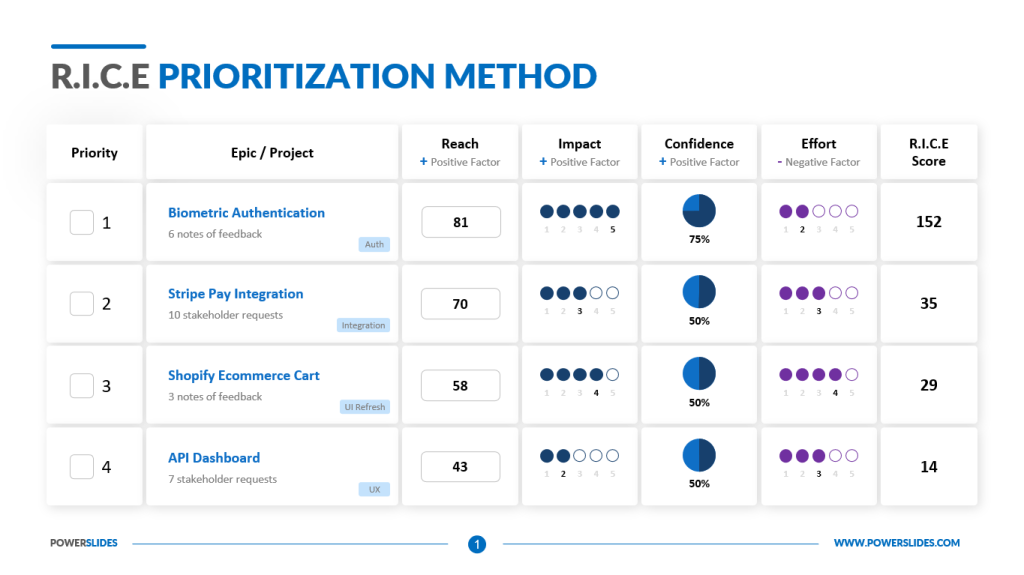
I want to do Digital Marketing
Help me create an optimized prompt using the RICCE FRAMEWORK
[ROLE]
[INSTRUCTIONS]
[CONTEXT]
[CONSTRAINTS]
[EXAMPLES]

To create an optimized prompt for Digital Marketing using the RICCE framework (Reach, Impact, Confidence, Context, Constraints, Examples), here’s how you can structure it:

1. Role
- Definition: The specific role or responsibility you’re targeting within Digital Marketing.
- Prompt Optimization:
- “As a Digital Marketing Specialist, what key objectives should I focus on?”
2. Instructions
- Definition: Clear steps or guidelines for achieving your goal.
- Prompt Optimization:
- “What are the essential steps to create and execute an effective digital marketing campaign?”
3. Context
- Definition: The situation or environment in which you’re operating.
- Prompt Optimization:
- “Given the current market trends and competitive landscape, how should I tailor my digital marketing strategy?”
4. Constraints
- Definition: Limitations or restrictions that might affect the execution.
- Prompt Optimization:
- “What are the budget, time, and resource constraints I need to consider while planning this campaign?”
5. Examples
- Definition: Real-life examples or case studies that can guide your approach.
- Prompt Optimization:
- “Can you provide examples of successful digital marketing campaigns in a similar industry?”

Final Optimized Prompt using RICCE Framework:
“As a Digital Marketing Specialist:
- What are the key objectives I should focus on for this campaign?
- What essential steps should I follow to create and execute an effective digital marketing strategy?
- Considering the current market trends and competitive landscape, how should I tailor my approach?
- What are the budget, time, and resource constraints I need to keep in mind?
- Can you provide examples of successful campaigns in a similar industry to guide my strategy?”
This approach will help you craft a comprehensive and focused digital marketing prompt, taking into account all critical factors.
► Prompt 1: Can you provide examples of successful digital marketing campaigns in a similar industry?
Here are some examples of successful digital marketing campaigns across various industries that you can draw inspiration from:
1. Nike’s “Just Do It” Campaign
- Industry: Sportswear & Apparel
- Campaign Highlights:
- Nike’s “Just Do It” campaign is one of the most iconic in marketing history. The campaign focused on motivating people to take action in their lives, regardless of the challenges they face.
- Digital Strategies: Social media engagement, influencer marketing, and user-generated content were key components. Nike encouraged users to share their stories on social media with the hashtag #JustDoIt, creating a global community.
- Impact: The campaign significantly boosted brand recognition and sales, particularly among younger demographics.
2. Airbnb’s “#WeAccept” Campaign
- Industry: Travel & Hospitality
- Campaign Highlights:
- In response to global issues of inclusion and acceptance, Airbnb launched the “#WeAccept” campaign, promoting diversity and inclusivity.
- Digital Strategies: Social media, content marketing, and video ads were used to convey the message. The campaign included a Super Bowl ad and widespread social media engagement.
- Impact: The campaign generated a massive positive response on social media, reinforcing Airbnb’s brand values and leading to increased brand loyalty.
3. Coca-Cola’s “Share a Coke” Campaign
- Industry: Food & Beverage
- Campaign Highlights:
- Coca-Cola replaced its iconic logo with the names of people on its bottles, encouraging customers to find a bottle with their name and share it with friends.
- Digital Strategies: The campaign was heavily supported by social media, where users shared pictures of their personalized Coke bottles. Coca-Cola also used targeted ads and content marketing to reach various demographics.
- Impact: The campaign was a huge success, leading to a significant increase in sales and social media engagement. It also created a strong emotional connection with the brand.
4. Dove’s “Real Beauty” Campaign
- Industry: Beauty & Personal Care
- Campaign Highlights:
- Dove’s “Real Beauty” campaign focused on challenging the conventional standards of beauty by featuring real women of different shapes, sizes, and backgrounds.
- Digital Strategies: The campaign used social media, video marketing, and user-generated content to promote the message of self-acceptance and confidence. Dove also encouraged women to share their own stories.
- Impact: The campaign resonated with a wide audience, increasing brand loyalty and setting Dove apart as a brand that champions real beauty.
5. Spotify’s “Wrapped” Campaign
- Industry: Music Streaming
- Campaign Highlights:
- Spotify’s “Wrapped” campaign provides users with a personalized summary of their listening habits over the past year, which they can share on social media.
- Digital Strategies: The campaign is driven by data personalization and social media. Users are encouraged to share their Wrapped summaries, which increases brand visibility and user engagement.
- Impact: The campaign has become an annual event that generates massive user engagement and social media buzz, strengthening Spotify’s connection with its users.
These examples demonstrate how effective digital marketing campaigns leverage social media, personalization, user-generated content, and a strong brand message to connect with their audience. You can use these strategies as a foundation to develop your digital marketing approach.

Prompt 2: As a Digital Marketing Specialist, what key objectives should I focus on?
As a Digital Marketing Specialist, your key objectives should be focused on driving growth, enhancing brand visibility, and maximizing customer engagement. Here are some critical objectives you should consider:

1. Increase Brand Awareness
- Objective: Enhance the visibility and recognition of your brand across digital channels.
- Strategies:
- Implement content marketing strategies like blogs, videos, and infographics.
- Utilize social media platforms to reach a broader audience.
- Run targeted display ads and PPC campaigns.
2. Drive Website Traffic
- Objective: Increase the number of visitors to your website.
- Strategies:
- Optimize your website for SEO to improve organic search rankings.
- Use paid advertising (PPC) to attract immediate traffic.
- Engage in content marketing and email campaigns to drive referral traffic.
3. Generate Leads
- Objective: Capture potential customers’ information for future follow-up.
- Strategies:
- Create compelling lead magnets like ebooks, webinars, or discounts.
- Use landing pages optimized for conversion.
- Implement email marketing campaigns to nurture leads.
4. Boost Conversion Rates
- Objective: Improve the percentage of website visitors who take desired actions, such as making a purchase or signing up for a newsletter.
- Strategies:
- Conduct A/B testing on landing pages, CTAs, and ads.
- Optimize the user experience (UX) on your website.
- Implement retargeting campaigns to bring back potential customers.
5. Enhance Customer Engagement
- Objective: Build a loyal customer base by engaging with your audience regularly.
- Strategies:
- Develop and maintain active social media profiles.
- Use personalized email marketing to keep customers informed and engaged.
- Create and share valuable content that resonates with your audience.
6. Improve ROI
- Objective: Maximize the return on investment (ROI) from your digital marketing efforts.
- Strategies:
- Monitor and analyze campaign performance using tools like Google Analytics.
- Focus on high-converting channels and strategies.
- Continuously refine and optimize campaigns based on data-driven insights.
7. Foster Customer Retention
- Objective: Increase customer loyalty and repeat purchases.
- Strategies:
- Implement a customer loyalty program.
- Use email marketing to keep customers engaged with personalized offers.
- Provide excellent customer service and after-sales support.
8. Expand Market Reach
- Objective: Enter new markets or reach new customer segments.
- Strategies:
- Conduct market research to identify new opportunities.
- Tailor your marketing messages to resonate with different demographics.
- Utilize social media and content marketing to enter new niches.
9. Optimize for Mobile
- Objective: Ensure your digital presence is mobile-friendly, as an increasing number of users access content via mobile devices.
- Strategies:
- Optimize your website and landing pages for mobile.
- Create mobile-friendly content and ads.
- Consider mobile app development if relevant to your business.
10. Monitor and Adapt to Trends
- Objective: Stay ahead of the competition by being responsive to the latest digital marketing trends.
- Strategies:
- Keep up with industry news and digital marketing trends.
- Experiment with new platforms and technologies like AI and automation.
- Continuously test and adapt your strategies to meet changing market demands.

By focusing on these key objectives, you can create a comprehensive digital marketing strategy that drives growth, builds your brand, and delivers measurable results.